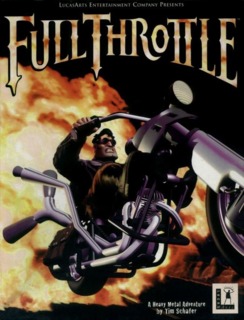INTRO:
The protagonists of most of LucasArts’ adventure games are talkative individuals. They rely on wit rather than brawn, sometimes to ludicrous extents (such as Guybrush did in LeChuck’s Revenge). In fact, most adventure game protagonists are outright wimps and are not accustomed to fighting. Understandably, there is the argument that any other kind of protagonists would not be suitable for games in this genre.
Full Throttle was a particular exception, and a memorable one too, for things both bad and good.
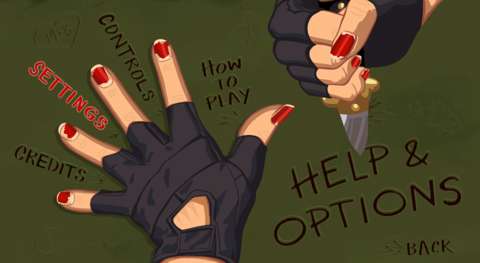
PREMISE:
The game is set in a somewhat sci-fi future. There are anti-gravity hovercraft tech and stable fuel additives for engine boosts.
This sci-fi future is masked with the geographical backdrop. It appears to be set in a version of the barren regions of central USA, where advanced technology is not so well received and reverence for the “old ways” are still around. Incidentally, these “old ways” include biker culture and carburettor-era automobile tech.
Geographically, the game takes place along fictional versions of the highways of the USA. Specifically, that place is Highway Route 9.
The player is introduced to Corley and Ripburger, the two top execs of Corley Motors, a manufacturer of reliable and robust motorcycles, among other loud vehicles like supercars. They are in yet another argument over the future of the company. Ripburger is in favour of broadening the company’s range of products to include minivans, something that Corley detests.
In fact, their relationship with each other is already very strained. Corley no longer trusts his long-time colleague, and Ripburger believes that Corley has to go if Corley Motors is to grow. However, instead of ironing things out or simply parting ways, Ripburger has a scheme to eliminate his colleague. This scheme involves hiring a gang of bikers as escorts to their shareholders’ meeting.
An incident with a biker gang damaged his limousine but otherwise impressed Corley. This gave Ripburger the opportunity that he needed to advance his scheme.
This biker gang is the Polecats, led by a stoic mountain of a man who simply goes by the name “Ben”. Ben is understandably wary of getting involved with corporate people, including even Corley, who quickly made friends with the bikers after some carousing. However, after some treacherous acts on Ripburger’s part, Ben is without his gang and has to figure out how to get back at Ripburger and save anyone else from the villain’s schemes.
BRUTISH BEN:
Even back then in 1995, Ben is notably very, very different from other adventure game protagonists. He is almost as tall as he is wide, and has a jaw that is far squarer than, say, Guybrush Threepwood’s. One would wonder why he is in such a game when the likes of him are more likely to be seen in a beat-‘em-up.
However, he is in this game, apparently as a deliberate contrast to the usual adventure game protagonists that Tim Schafer and pals know about. Indeed, how he handles the first few hurdles in the game would suggest that he prefers more physical means of solving problems.
The later puzzles would also reveal that Ben is mindful of any risks from violent solutions. For example, he will not tussle with a dude that has a knife, at least while he is not on his bike. For another example, he will also run away to avoid trouble that would bog him down. For yet another example, he will not fight a vicious dog if he risks severe bites. In yet another example, he will not bother expending energy to kick down a sturdy door when he could look for other means.
(The player can still have him kick things anyway though, just for the hell of it.)
Such down-to-earth moments quickly disabuse the player from any notions of having him simply man-handling people to get things done his way. The player will have to use the usual means of overcoming obstacles in adventure games, like observing things in the environment, examining things in the inventory and figuring out how these can be manipulated by following a line of reasoning.
Still, where possible, Ben would make use of his robust physique. One example is shown early in the game; he chooses to climb into a location instead of going through its main entrance.
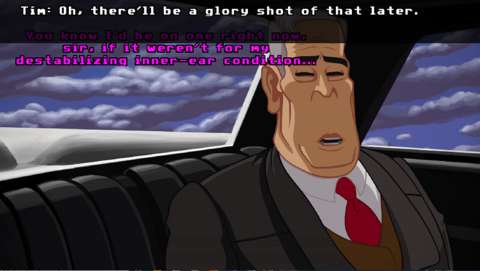
STOIC BEN:
Ben does not talk much. Indeed, his monologues are short. The most entertainment to be had from his monologues is his dry wit and dark humour.
He will not be making any statements about his backstory either. He will have no monologues about his relatives, unlike Guybrush Threepwood of Monkey Island. If anyone asks about his personal details, he gives a terse reply about not wanting to talk about them.
There are moments in which Ben is less guarded, such as when he comes across his mentor and predecessor, Father Torque. Still, the player should not expect much of anything about his backstory. In fact, only one character would have her backstory almost completely revealed.
OTHER CHARACTERS:
Like Ben, most other characters are not above acts that are harmful to others, if they get things done to their satisfaction. There are Ripburger and his two henchmen, who eagerly go after loose ends in their scheme. There are other people of the road, who would either use their vehicles as dangerous implements or just to carry them in battle.
Not all of them are as memorable as Ben though, either because they do not get a lot of screen-time or they do not appear prominently in the gameplay. For example, Maureen is a significant character in the story, but other than being an errand-giving character in the early parts of the playthrough, her only other involvement in the gameplay is as someone that Ben has to reach in a tedious mini-game.
Ripburger is perhaps the only other character that is worth remembering, mainly due to his name and his villainous determination. Still, his character designs have not aged well; at present, he would have been just another ruthless corporate suit that is not above murder.
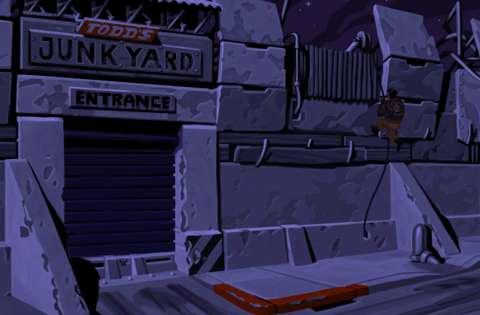
SOLUTIONS:
As mentioned already, if Ben could kick something down to get it out of the way, he would.
However, many later hurdles are simply too much for him to overpower without serious risk. They would require him to use something on something else, or remember certain details (or to be more precise, having the player recall these). Ben will also resort to hiding out of sight and keeping quiet; he may prefer quick and brutish solutions, but he will not attract more trouble than he has to.
Perhaps the most notable difference in the solutions to obstacles and puzzles in this game compared to those in other adventure games – both of way back when and of today – is that there is no item combination. That is not to say that Ben is an oaf; a certain solution involving a lockpick would show that he definitely has fingers that are nimble enough. Rather, there is not any reason for him to MacGyver things together.
Most obstacles have him using one thing on something else. The most complicated of them involves using multiples of the same thing on something else, after performing a sequence of simple (and explosively loud) shenanigans. (Incidentally, according to the developer commentary, this particular scene was one of the things responsible for this game going over-budget, in addition to the primary reason for Tim Schafer being a slacker.)
TECHNICAL LIMITATIONS - FOREWORD:
Although this remaster has been rebuilt using something else other than SCUMM, the game retains some technical limitations due to oversights on the developers’ part.
ONLY NINE SAVE SLOTS:
There are only nine save slots, in addition to an auto-save that triggers every minute outside of the final act. Moreover, the display for the nine save slots makes use of huge boxes and big text, thus requiring the player to do some scrolling that would have been unnecessary if the user interface design had been more space-efficient.
Fortunately, nine slots are enough, because the game’s progression is rather linear and it is short.
CAN ONLY SAVE IN SCENES WHEN BEN IS NOT MOVING:
The player cannot make a game-save in any scene other than the typical scene of a SCUMM player character standing about or having his sprite slide along invisible rails or grids. Apparently, the game cannot reload into these non-standard scenes. This limitation is a problem in one segment of the game where Ben has to fight other bikers.
SKIPPING CUTSCENES:
When the animated cutscenes occur, the player can do to hurry things along is to skip spoken lines. However, to actually skip the animations too, the player needs to use the Backspace key, which is different from the control input for skipping the lines. This is, of course, a vestige of LucasArts-era programming; most present-day adventure games do not even use the Backspace key.
LIMITED INVENTORY DISPLAY:
When the display for Ben’s inventory is brought up, only a few items are shown, despite the size of the window for the inventory display. This is because the icons for the items are huge. The icons are also boring to look at, due to their grayscale palette. Ben also has nothing much to say about them because he is taciturn, so the player should not expect much humour to be had from the items.
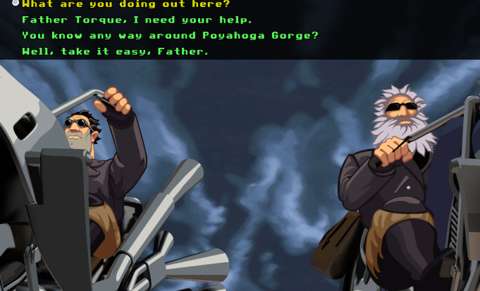
MUST COMPLETE/SKIP NPC SPOKEN LINES BEFORE SCENE TRANSITION:
When Ben is on foot, double-clicking on a scene skips the animation of him walking over to the exit. This also ends any of his monologues, if he is uttering any (which is a rare occasion – he is taciturn, even to himself).
However, if there is any NPC on-screen that is saying things, the NPC’s spoken lines must be completed or skipped before the scene transition can happen. Until then, Ben stands in front of the scene exit. Such oddities can be irksome, but thankfully, this only happens in one scene involving a stall hawker.
BIKING SEGMENTS:
There are more gameplay systems than just pointing and clicking. One of these gameplay systems can be seen in the later acts in the story, specifically when Ben has to fight bikers in the mine roads.
There are abandoned mines off Highway Route 9. These mines were serviced by roads that had long been abandoned. Apparently, this is a favourite haunt of bikers, who roam these roads looking for other bikers to fight and rob. Ben will do so too, mainly to rob them of their usable and portable gear.
Ben will beat up other bikers and force them off their bikes. Presumably, while they are down and out, Ben retrieves some of their equipment, especially whatever they had been using in the fights. Other things, such as cannibalizing their bikes, are major no-no’s. However, Ben’s ultimate goal is to steal one of the sci-fi doo-hickeys that a particularly tech-savvy biker tribe have.
Ben must keep to the roads or worn-down rock paths. Veering too close to the curbs or rock walls will cause him to wipe out. Ben will also wipe out if he gets forced off his bike. However, Ben’s physique and constitution are such that he gets back up quickly, and his bike is similarly robust (thanks to a gear-head lady friend that has repaired it and buffed its frame). However, he might lose some of his pilfered gear if the player chose wrongly. For example, using a plank against a biker that is using a chainsaw is not likely to end well.
When Ben is on Route 9 or the mine roads, there are signs that indicate the presence of detours up-head. Using the prompts that appear on-screen causes Ben to take these detours. Missing the prompts causes him to continue driving along the path.
The player cannot make a game-save at any time during the biking segments. To make a game-save, the player must go to a locale where Ben stops his bike.
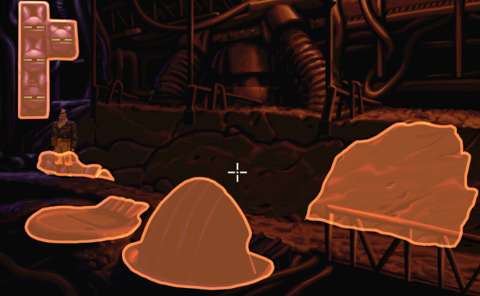
CLUMSY CONTROLS:
The player can choose to use the mouse or keyboard for these segments, but not both. Having both could have provided far more reliable control, but apparently the designers do not have the technical skill to implement this.
The location of the mouse cursor is not important to the gameplay of these segments. Therefore, it has been rendered invisible so that it does not get in the way of the other visuals. This is actually not for the better.
Trying to play these segments with a windowed mode can be frustrating. The game will not lock the mouse’s locational inputs into the window for the game. It is very easy for the player’s mouse cursor to veer out of the window because the player is also not shown the exact location of the mouse cursor due to reasons that had been mentioned earlier.
BUTTON-MASHING FIGHTS:
Ideally, the player should have Ben use the correct weapon for the right enemy. Each weapon is coded to have different reach and damage output. The weapons with the longest reach are needed to deal with certain bikers that Ben needs to rob. One certain biker has a weapon that will knock out Ben if she manages a solid hit, and she is generally unbeatable unless Ben uses a cheap tactic on her.
For most other bikers, all the player needs to do is have Ben stun-lock them with the weapon that has the fastest attack rate. Incidentally, these are his fists. He will not be doing much damage, but his opponent can do nothing much when their animations are being reset under the onslaught of punches.
RANDOM ENCOUNTERS:
For better or worse, the mine road segments depend on random encounters. Ben might encounter the same few bikers over and over until he eventually comes across those that the player wants him to defeat. The player cannot make game-saves in these segments, by the way.
Conveniently, there is a cheat input that can be used to defeat any biker immediately. That the developers actually left this input in the game is already evident of how tedious that these segments can be.
UNDERWHELMING DERBY SCENE:
The most disappointing attempt at implementing different gameplay is that for the so-called “demolition derby” scene. The solution for this scene involves exploitation of unbelievable design flaws in the hovercraft that is present in this scene. The controls and physics that are used to bring about the solution are clumsy too, though not terribly clunky (at least in the remastered version of the game). The player has to push hovercraft around, making use of their unconvincingly inconsistent inertia to get them somewhere.
There is actually a combo keyboard input that can be used to skip this scene, but the skipping does not include exposition on the context for the solution to this scene.
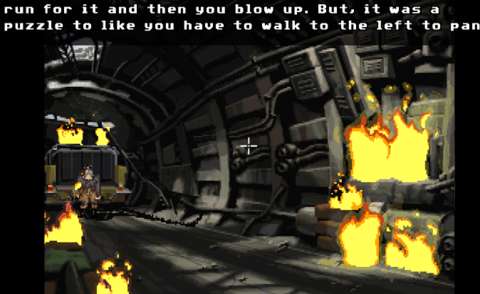
TIMED FINALE:
The scenes in the final act are all timed. The timers are not shown to the player, though they are not using the same countdown, i.e. each scene has its own timer and initial countdown. Having the countdown go to zero gives the player a game-over screen, followed by a scene reload.
In the original game, these scenes would have been problematic, due to having to spend time to observe the responses of the antagonist to the player’s attempts to have Ben work around obstacles. Without access to a walkthrough, the player might have to reload a few times.
VISUAL DESIGNS:
Although the remaster is using Unity to glue its assets together, the developers have retained the “feel” of the SCUMM engine as much as possible. In particular, the use of 2D layers have been retained. Characters can have their sprites swapped and backdrops can have their artwork changed smoothly with the press of a button. This is not unlike what has been done for the remasters of the first and second Monkey Island games.
For ease of reference, the new graphics filter will be referred to as the “remastered” mode and the pixelated version will be referred to as the “retro” mode.
Due to the use of the same framework to place and move objects on-screen, the retro mode does not look entirely convincing. For example, moving sprites do not have their pixels perfectly aligned with the pixels of other on-screen things, i.e. the raster graphics of the original could not be completely reproduced.
The sprites in the remaster mode are merely touched up versions of the originals, with no additional animations. They look better when characters are standing still, but the moment when they start moving, the lack of frames becomes noticeable.
Still, at least the charm of the original visuals has been retained. For example, there is Ben’s goofy running pose, which he exhibits when he is escaping from something or rushing over to hide behind something. (Incidentally, there are a lot of things that are big enough to hide his wide silhouette.)
There are of course, the motorcycle tricks that Ben would gratuitously pull off. That said, the hilarious scene of his motorcycle coming apart during a rear wheelie is more amusing in the remaster, because the strain on his face is more visible.
The mishmash of Road Warrior and Hell’s Angels aesthetics is apparent throughout most of the game. This is apparent even in the penultimate act, when the factory complex of Corley Motors is shown. The complex’s exterior has noticeably patchwork metalworking, although whether this is indeed the structural composition of the complex or merely surface-level cosmetics is unclear. (The latter is very likely.)
The game utilizes the pie menu that had been introduced in Sam & Max Hit The Road, an earlier SCUMM game. The pie menu is obviously inspired by metal rock aesthetics. However, the context-sensitive locations of the pie menu for looking at and talking to things are a tad close to each other, due to the use of a rather flat cartoon skull.
Perhaps the most welcome improvement that the remaster brings is the horizontal extension of the scene boundaries. The original game has some frustrating scenes, especially the very last one, because certain things that the player needs to look at are cropped out by the limited boundaries in the original game’s visual designs.
The least visually impressive part of the game is the segment that takes place in the mines that are situated next to Highway Route 9. The player will be seeing the same boring rock formations over and over. The remastering has not improved the appearance of the rocks by much, due to the lack of frames. Perhaps such scenes could have been great during the mid-1990s, but they really show their age now.
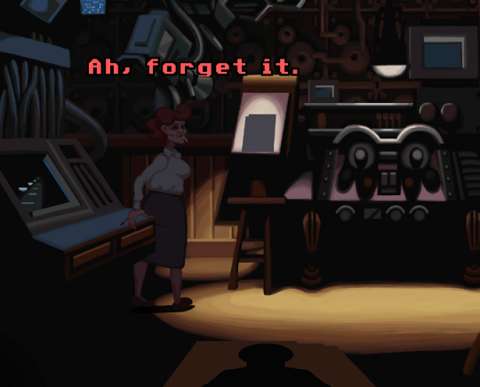
SOUND DESIGNS:
The aforementioned pie menus come with their own sound effects, namely the sounds of burning fires. These sound amusing, at least until the player realizes that they can cut out ambiance and other sound effects, and sometimes even music.
Speaking of music, the original game had benefited from the use of licensed tracks, most of whom are provided by the Gone Jackals. The tracks are mostly metal, with only a few being convincingly heavy metal. These play prominently in the biking scenes.
However, the others are no less prominent, due to their use in providing the atmosphere of certain scenes. For example, in the scenes involving the Kickstand bar, there are tracks with volumes that change according to Ben’s current location, which is either outside the bar or inside it.
As for sound effects, the most prominent of these are the sounds for the motorcycles and other vehicles as they grind asphalt and gravel. Apparently, the production team actually hired real bikers so that they can take sound samples. They also used robust hardware because of how loud the bikes can get. Ultimately though, it is the skill of the composer, Peter McConnell, and his colleagues that have the sound clips implemented in a convincing manner, including even for the remaster.
Then, there are the more generic noises that the (now formerly) LucasArts designers have no problem with. There are also explosions (as the famous cover art of the game would suggest) and the noises of industrial machinery, for example.
However, the player should not expect many other sound effects. After all, the barrens of the USA that the highways cut across are vast, lonely and quiet places.
The best sounds are the voice-overs for the characters. Many of them were already well recorded and cleaned up in the first place, so reusing them for the remaster is not an issue, at least according to the developer commentary. That said, some of the surviving voice talents would go on to be well sought-after; their satisfying performances in Full Throttle are evident of this outcome. Of course, Roy Conrad is long deceased, but this game and its remaster would continue to be reminders of the wonderfully deep bass that he has provided to Ben’s voice-overs.
DEVELOPER COMMENTARY:
The remastered version of Full Throttle has commentary by the people who worked on the game. This includes Tim Schafer, perhaps the most entertaining and also most insufferable person on the team. Much of the commentary will sound like a post-mortem, with anecdotes about how the designers came up with the ideas for certain things in the game. There is also candidness, such as how short the game is and how it went over-budget because they were over-reaching their abilities to produce the game.
Perhaps the most interesting commentaries are how they dealt with the technological limitations of the time. The tale of the game’s producer trying to contact Tim Schafer on the phone when there were no mobile devices is notable.
The main problem with the developer commentary is that they can happen during the story-progressing cutscenes too. The commentary will overpower the characters’ voice-overs, and the subtitles for the commentary will overlap those of the voice-overs wherever they appear to share the same spot on-screen.
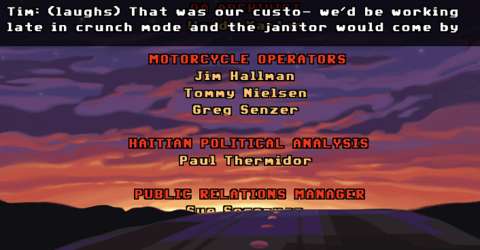
SUMMARY:
Ultimately, if anyone remembers this game, it would be remembered not for its gameplay. Indeed, this game’s attempts to veer into gameplay other than point-and-click are just unreliable and unpleasant.
Rather, people would remember this game for its characters – Ben, in particular. Ben is an amusingly different adventure game protagonist that might even seem out of place. There is also the setting, which is a peculiar mix of highway culture and vehicular science fiction.
The remastering delivers on the presentation of the story-telling. In addition, advancements in tech – namely wide-screens and more detailed colour palettes – also solved issues in the original game. Since the original game has audio production of considerable quality, the remaster benefited from the reuse of the already-good audio assets.
Yet, the remaster retains the original game’s design foibles, such as the aforementioned combat on wheels. It is also exceedingly short, especially considering that this was one of LucasArts’ expensive projects.
It has a lot of style that would hold up even in the present day, but that is just it.
